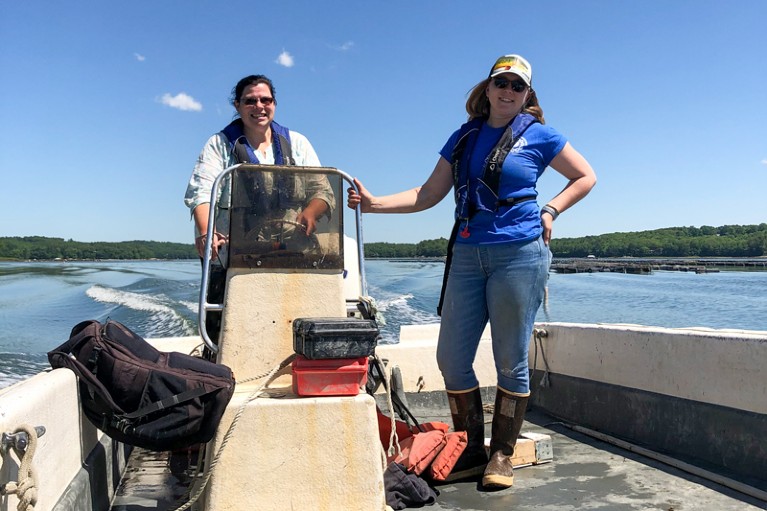
Meredith White (left) working in the field with EPSCoR Student Emma Christman. Credit: Laurie Bragg/ME EPSCoR
In 2013, Meredith White received her PhD from the MIT–Woods Hole Oceanographic Institute Joint Program in Massachusetts, where she focused on the biological impacts of ocean acidification. In 2016, she accepted a position as the first director of research and development at Mook Sea Farm, an oyster farm in Walpole, Maine.
How did you first get involved in aquaculture?
When I finished graduate school, I didn’t want to pursue a tenure-track position in academia: I found the prospect of securing a personal salary through grant applications too stressful.
Some of the work I did in graduate school was related to aquaculture, and I thought working in aquaculture would be really cool. But at that point, having just gotten my PhD, I thought that I was overqualified to work in a hatchery.
What changed your mind?
In 2015, I was teaching at Bowdoin College in Brunswick, Maine, as a visiting assistant professor. One of my advisees was working on a project centred on young oysters. We met with Bill Mook, who owns Mook Sea Farm, to talk about that project. I already knew Mook from our work on Maine’s Ocean Acidification Commission, which gathered a group of experts in 2014 to create a report on how ocean acidification was affecting Maine’s commercially important species. I shared my scientific expertise in the report; Mook served as an aquaculture representative.
During our 2015 meeting, Mook mentioned that he was hoping to hire a research scientist. When he said, that, I thought: “that’s perfect, that’s what I want to do”. My interests were not in business, but in research. That’s how I came to this position.
What kind of research topics are you working on now?
I’m working on everything from changes in precipitation patterns to warming water, increases in human and oyster pathogens, ocean acidification, changes in salinity and the increasing frequency or duration of harmful algal blooms. Almost everything we’re doing in some way is to build the resiliency of the company as environmental conditions change.
What appeals to you about working in this industry?
My job has a great work–life balance, and that’s important to me. I did not feel that was the case in academia. And I really like how quickly the results of my research can be used. We’re not waiting months and months to publish a paper. I can do a project and literally the next day the results can have an influence on the operation of this business.
Do you share your research findings with other companies?
We would share findings from many of our projects. This summer, we completed a project looking at the impacts of ocean acidification on young oysters’ calcification rates, and we plan to publish this work in a peer-reviewed journal. But some of our projects could give our business a competitive advantage, so we wouldn’t necessarily want the results to be shared.
Do you see others scientists seeking work in this field?
I definitely do. I’ve had a lot of people ask me how I found this job — people who are not looking for academic jobs or who are finding that these jobs are not readily available.
How might someone in academia land a job in aquaculture?
Interested scientists should talk to regional aquaculture associations to determine whether they know of farms that might be ready to hire their own research scientist. Finfish aquaculture companies, such as salmon farms, tend to be larger than shellfish farms and have more positions for research scientists on staff. There are more opportunities in that industry.
Are you happy with your career shift?
For me, this is the best fit I’ve ever had in a job. I feel incredibly fortunate.

 Food security
Food security







